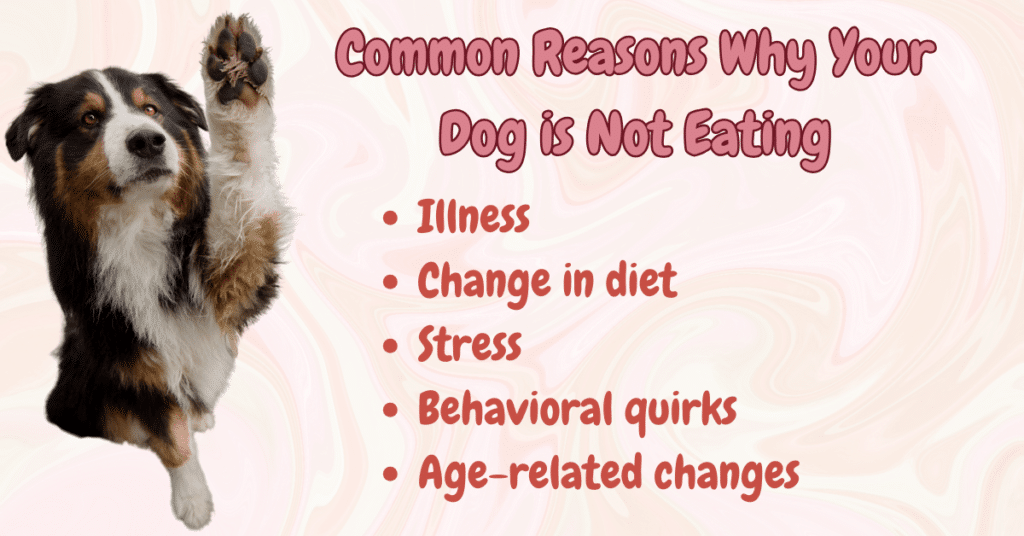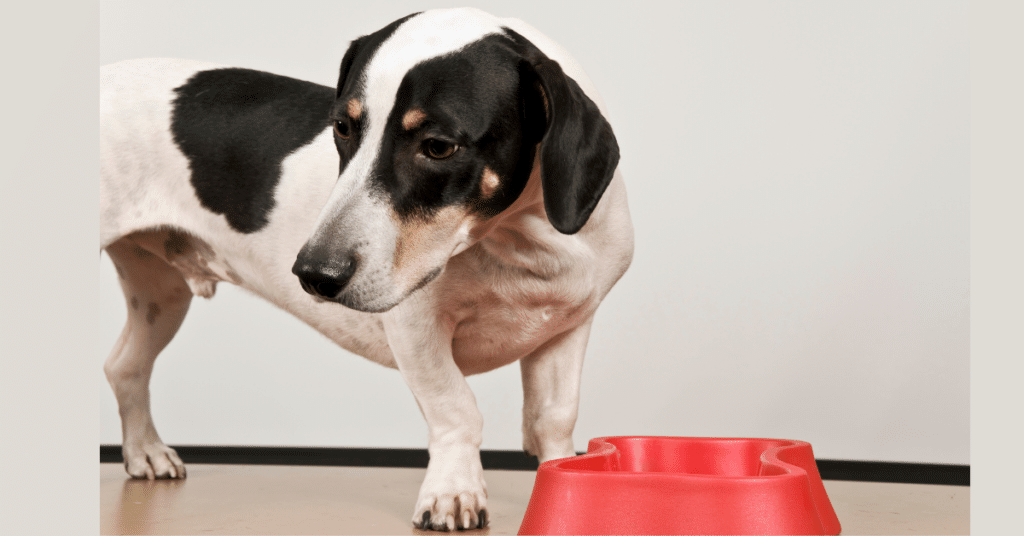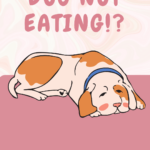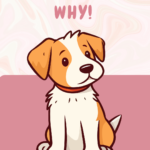You plop your dog’s food bowl down, expecting the usual enthusiastic tail wags and happy chomping. But instead, your dog gives it a disinterested sniff and walks away. You begin to wonder, “Why is my dog not eating?”
A dog’s refusal to eat can be caused by an illness, changes to their diet, stress, or their age, but it can also be caused by them waiting to see if they’ll get something more delicious to eat!
Understanding the potential reasons and when to seek veterinary help is important for getting your pup back to normal. Sometimes, a lack of eating isn’t anything to worry about and can be waited out. But other times, a visit to the vet is needed.
Let’s take a look at the most common reasons dogs stop eating.

5 Reasons Why a Dog is Not Eating Their Food
If you’re puzzled at the sight of an untouched food bowl, several underlying causes may exist. A sudden lack of appetite is often concerning, but you may not need to panic. Here are some of the most common reasons why your dog is not eating.
1. Illness
When your dog refuses their food, your primary concern is probably that they are sick. Loss of appetite can indicate a lot of different diseases.
A stomach ache is often plenty for many dogs to stop eating altogether. Sometimes, it’s something rather simple, like a stomach bug. Other times, it may be a more serious bacterial or viral infection, which can absolutely cause a loss of appetite.
Take a trip to the vet if other symptoms accompany the lack of appetite including:
- Vomiting
- Diarrhea
- Lethargy
- Signs of pain
Early detection is often important for finding and treating the underlying illness.
Additionally, some medications can also cause loss of appetite. Furthermore, if a dog was previously sick, they may relate their past illness to their dog food (especially if nausea or similar symptoms occurred), leading to long-standing food aversions.
2. Dietary Problems
Did you recently switch your dog’s diet? Even if it’s the same brand, a sudden change of food can be off-putting, especially if your dog has been eating the same thing for years!
The more different the new food, the more likely your dog is to reject it – at least at first! If you switch the type of food, for instance, your dog will likely end up with a stomach ache or not eat it. For this reason, slowly transitioning the food is vital.
Always ease in a new food to prevent this problem.
3. Environmental Stressors
Even the most chill dogs can be fazed by sudden changes in their environment. Travel, new routines, loud noises, or other stressful events can lead to a loss of appetite. If your dog just got back from the groomer, it isn’t uncommon for them to be disinterested in food.
Sometimes, you can make changes to lower your dog’s stress levels. Other times, you’ll just have to wait it out.
4. Behavioral Quirks
Some dogs have picky eating habits. This is a personality thing, just like some people are pickier than others. Some dogs may simply decide that they don’t like their kibble and refuse to eat it. Instead of eating their kibble, they might hold out for tastier scraps from the dinner table or yummy treats.
If your dog is used to you paying attention to them while they eat, they may use mealtime in an attempt to get extra attention. They may whine at their bowl to encourage your petting, for instance.
Resist the urge to give in – giving them treats or table scraps only reinforces their picky behavior. Unless your dog has underlying health issues (which I recommend checking for), they should eat when hungry!
5. Age-Related Changes
As dogs age and become seniors, their metabolism often slows down. They may also become less active, especially if they have joint pain. These factors can lead to them needing less food, so they may naturally eat less.
This is a normal part of aging and often isn’t anything to be concerned about.
That said, dental problems are also more common with age and can lead to appetite loss. Therefore, I highly recommend a vet visit if your dog shows any other signs of dental problems.
Common signs of dental problems include:
- Difficulty chewing
- Dropping kibble
- Refusing to play
- Pawing at their mouth

When Should I Worry About My Dog Not Eating?
A skipped meal here and there probably isn’t a cause for concern. However, there are situations where a lack of appetite can warrant a vet visit. Here are some red flags I recommend watching for:
- Not Eating for More than 24 Hours: If your dog continuously refuses food for a day or more, it is time to call the vet. We recommend calling even sooner if your dog has other symptoms, too, like lethargy or vomiting.
- Difficult Eating: If your dog tries to eat but flinches or paws at their mouth, it could be a sign of dental problems. Sadly, dental issues are very common in dogs and can also be very serious.
- Weight Loss: If your dog is losing weight in addition to not eating, it’s a strong indicator of an underlying medical condition. Plan to see your vet sooner rather than later. Early treatment is important for most illnesses.
- Other behavioral changes: If your dog is acting weird in any other way, it could be a sign of illness. For instance, if your dog usually jumps up for a walk but is now dragging their paws, it could signal that something is wrong.
If your dog has any of these symptoms on top of loss of appetite, it’s time to call your vet. Of course, I always recommend calling your vet when you’re concerned. It’s typically better to get your dog checked out than not!
Why Is My Dog Not Eating Their Food But Acting Normal?
Dogs can be confusing! If your dog seems happy and content despite refusing food, it can be perplexing, to say the least! While it’s possible it’s a temporary issue like a mild digestive upset, it’s best to monitor them closely.
If your dog has no other symptoms, there may not be a reason to rush them to the vet for now. Consider if your dog has experienced any recent event that they may think is stressful. Dramatic events like introducing a new pet to the household or traveling can all cause stress.
Even seemingly minor changes in routine or environment can trigger a temporary loss of appetite in some dogs.
Sometimes, a decreased appetite can indicate a developing illness that hasn’t caused other symptoms yet. If your dog’s loss of appetite continues for more than a day, you should consult your vet. In the meantime, watch out for new symptoms.
Tips on Getting Your Dog to Eat Food Again
If you have ruled out health concerns and your dog is still not eating, there are several ways you can encourage them to eat again.
Here are a few tips:
- Warm up their food: Adding a bit of moisture to your dog’s kibble and slightly warming it can make it more enticing for them. You can also heat up canned food in the microwave without adding extra moisture.
- Add low-sodium broth or wet food: A spoonful of low-sodium broth or wet dog food can add moisture and flavor to dry kibble. You don’t want your dog to get used to these additions, but they can help jump-start your dog’s appetite.
- Offer small meals: Instead of one large meal, try offering smaller portions more often. Some dogs just don’t like to eat a lot in one sitting.
- Provide a quiet environment: Your dog should preferably feel calm and secure during mealtimes. Don’t feed them in chaotic areas. Sometimes, your dog may need to be fed away from other pets.
Typically, you don’t have to continue doing these tips forever! A few eaten meals can help your dog’s appetite start back up.
Final Thoughts
It’s important to remember that a dog’s appetite is a crucial indicator of their well-being. If your dog isn’t eating, it’s because something else is going on.
Sometimes, this is something serious, like an underlying illness, and calls for a vet’s attention. Other times, it could be because they’re stressed or don’t like their new food. When in doubt, always speak to a vet. After all, it’s much better to get your dog checked out than not.



